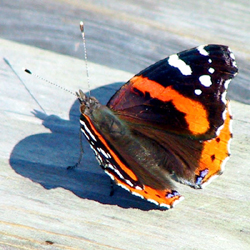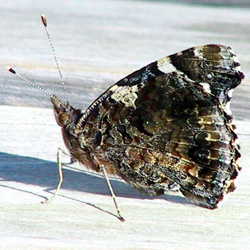Find a Butterfly
Red Admiral
Vanessa atalanta
Named
Linnaeus, 1758

Taxonomy & Nomenclature
The North American subspecies is Vanessa atalanta rubria (Fruhstorfer), 1909. Nabokov notes (Speak Memory, 1960) that the common name in English was originally Red Admirable.
Identification
Wingspan: 1 3/4 - 2 1/4". Unmistakable. The dark ground color of the wing surfaces with the bright orange (pinkish below) diagonal band across the forewing is unique.
Distribution
Holarctic. Throughout North America from southeastern Alaska east to Newfoundland and southern Labrador and south to Guatemala and the Greater Antilles. Established in Bermuda. Also throughout Europe and Central Asia to Pakistan and south to North Africa. Introduced in New Zealand and Hawaii. In North America overwinters only in the South.
Status in Massachusetts
A migratory species that does not winter in the state. Its numbers in any given year are therefore variable - from uncommon to abundant throughout the state - depending on the nature of that year‘s migration as well as the success of the resulting breeding populations. Atlas records seem to indicate that it may be less frequent as a breeding species on outer Cape Cod. Subject to occasional irruptions as in 1990 (See Notes, below). Maxima: During the migrations of 1990 there were instances of hundreds per hour moving rapidly inland along the coast; non-migrant maximum: 12, Northbridge (Worcester Co.), 24 July 1994.

Flight Period in Massachusetts
Red Admirals are on the wing almost continuously from May into October; however, there tend to be three discernable peaks: May, July, and late August to early September. See Life Cycle, below, for details of the breeding sequence. Extreme Dates: 8 April 1994, Gay Head, Martha‘s Vineyard (Dukes Co.), A. Keith; 9 April 1994, Westport (Bristol Co.), S. Bolton; 30 October 1968, Marblehead (Essex Co.), C. Leahy; 2 December 1990, No. Monomoy Island (Barnstable Co.), S. Perkins.
Larval Food Plants
Nettles and (possibly) Hops (Humulus lupulus). New England nettle species used include: Stinging Nettle (Urtica dioica)* (and probably the native Tall Nettle, U.procera), False Nettle (Boehmeria cylindrica), Pellitory (Parietaria pensylvanica), and Wood Nettle (Laportea canadensis).
Adult Food sources
Attracted to sap flows, the juices of rotting fruits, excrement (including bird droppings),and wet soil. While some authorities assert that Red Admirals visit flowers infrequently, Atlas volunteers found them often on a wide variety of plant species (14), including privet, milkweeds, Purple Loosestrife, Cow Vetch, Meadowsweet, Joe-Pye Weed, and goldenrods.

Habitat
The larval host plants of atalanta are mainly understory species of floodplain forests and other moist woods. But far from keeping to this shady element, the butterfly is a broadly tolerant species equally at home basking and darting around in sunny gardens and perching quietly on shade-dappled tree trunks. It is known to remain active until late in the day and has even been recorded coming to lights and to moth collectors‘ sugaring trees after nightfall. During its dispersals, it can appear anywhere from ships at sea to the streets of large cities.
Life Cycle
EGG: A tall green dome with well marked vertical ridges converging at the top. OVIPOSITION: Eggs are laid singly on the top of host plant leaves. LARVA: Greatly variable in color from mostly black to gray, brown, reddish, yellow , green or combinations thereof and decorated with lateral lines and dots; the mature caterpillar bears rows of bristly spines. Caterpillars "sew" the edges of foodplant leaves together with their silk and feed on the leaves from which the shelter is made. CHRYSALIS: Pale gray with gold dots, armored with squat spines; generally resembling a shriveled dead leaf. PUPATION: Takes place within the last leaf shelter constructed by the larva. OVERWINTERING STAGE: Adult, but does not overwinter in New England.
The first Red Admirals appear mainly after the first week in May. This early flight represents migrants from overwintering populations in the South (c. North Carolina southward). Males take up lookout perches on tree trunks, rocks, roof tops, and other prominent locations (or simply on the ground) and dart out to investigate passersby, including people as well as prospective mates. Mark and recapture studies have shown that perch sites change frequently and that adults of this species travel widely even during the mating period. Adults from the spring brood begin to appear in early July and repeat the reproductive cycle resulting in a third generation of adult butterflies that flies from late August to October. At least some individuals from this fall generation migrate south, but little is known of their ultimate fate.
Notes
Instances of migrating Red Admirals sometimes involving "enormous numbers" have been recorded in Europe and the United States for over a hundred years (Williams, 1930). The last year of the Massachusetts Butterfly Atlas Project (1990) was such a year with hundreds of butterflies seen to be moving rapidly westward or inland especially along the coast, e.g. 119, Fairhaven (Bristol Co.), 10 July 1990, (nectaring on privet), B. Cassie; crossing beach at about 12 per minute, c. 300 counted within an hour period, Rockport (Essex Co.), 15 July 1990, C. Leahy. A similar movement may also have taken place in the Old World in 1990 with records of migrating Red Admirals from the western shore of the Caspian Sea. Historically, these flights have been recorded mainly in May and in September, corresponding to spring and fall emergence peaks, but the phenomenon in Massachusetts peaked in mid-summer and had waned by the end of July. The record also includes several instances of numbers of this species being seen at sea hundreds of miles from the nearest landfall. Many accounts note the rapidity and apparent "purposeful-ness" of the butterflies‘ flight. The origin or "triggers" of these Red Admiral migrations remains unknown, and no mass emergences from well-defined natal areas (see Painted Lady) have been described.
Account Author
Chris Leahy



